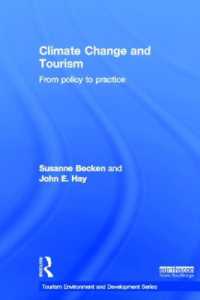- ホーム
- > 洋書
- > 英文書
- > Science / Mathematics
Full Description
Climate Change Biology, 2e examines the evolving discipline of human-induced climate change and the resulting shifts in the distributions of species and the timing of biological events. The text focuses on understanding the impacts of human-induced climate change by drawing on multiple lines of evidence, including paleoecology, modeling, and current observation. This revised and updated second edition emphasizes impacts of human adaptation to climate change on nature and greater emphasis on natural processes and cycles and specific elements. With four new chapters, an increased emphasis on tools for critical thinking, and a new glossary and acronym appendix, Climate Change Biology, 2e is the ideal overview of this field.
Contents
AcknowledgmentsSection 1. IntroductionChapter 1. A New Discipline: Climate Change BiologyA Greenhouse PlanetBoundaries of LifeShifting InteractionsChemistry of ChangeLinkages Back to ClimateClimate Change BiologyChapter 2. The Climate System and Climate ChangeThe Climate SystemEvolution of the Earth's ClimateNatural Drivers of ChangeMajor Features of Present ClimateStable States of the SystemHuman-Driven Change: Rising CO2Rapid Climate ChangeThe Velocity of Climate ChangeModeling the Climate SystemRegional Climate ModelsCommonly Used GCMsEmissions PathwaysGCM OutputsBiological Assessments with Downscaled DataSection 2. The Impacts of Human Induced Climate ChangeChapter 3. Species Range ShiftsFirst Sign of Change: Coral BleachingFirst Changes on LandMounting Evidence of Range ShiftsPatterns within the PatternsExtinctionsFreshwater ChangesPests and PathogensChapter 4. Phenology: Changes in Timing of Biological Events Due to Climate ChangeArrival of SpringFreshwater SystemsSpring Ahead, Fall BehindTropical Forest PhenologyMarine SystemsMechanisms: Temperature and PhotoperiodLife-Cycles of Insect HerbivoresTiming Mismatches Between SpeciesChapter 5. Ecosystem ChangeTropical Ecosystem ChangesCloud ForestsTemperate Ecosystem ChangeHigh Mountain EcosystemsGlacier and Snowpack-Dependent EcosystemsPolar and Marine SystemsPolar Food Webs: Changes in the Southern OceanTropical Marine SystemsPelagic Marine SystemsOcean AcidificationEcosystem Feedbacks to Climate SystemSection 3. Lessons from the PastChapter 6. Past Terrestrial ResponseScope of ChangeThe Earth MovesClimate Runs Through ItFast and Far: The Record of the Ice AgesIce Racing in North America and EuropeOut of Land: The Southern Temperate ResponseNorth Meets SouthRapid Change: The Younger DryasTropical ResponsesMilankovitch Forcing in the Biological RecordLessons of Past ChangeChapter 7. Past Marine Ecosystem ChangesEffects of Temperature ChangeEffects of Sea-Level ChangeChanges in Ocean CirculationChanges in Ocean ChemistryChapter 8. Past Freshwater ChangesLakes as Windows to Past ClimateTypes of Freshwater Alteration with ClimateFreshwater Biotas, Habitats, and Food ChainsDeep Time: Pace of Evolution and Species AccumulationRecent-Time (Tertiary and Pleistocene) Records of ChangeFast ForwardChapter 9. ExtinctionsThe Five Major Mass ExtinctionsCauses of Extinction EventsClimate as the Common Factor in Major ExtinctionsImpacts and ClimateDoes Climate Change Always Cause Extinction?Climate and Extinctions in Deep TimeThe Past 100 Million YearsThe Past 2 Million Years: Extinction at the Dawn of the Ice Ages and the Pleistocene ExtinctionsThe Missing Ice Age ExtinctionsPatterns in the LossesSection 4. Looking to the FutureChapter 10. Insights from ExperimentationTheoryLaboratory and Greenhouse ExperimentsField ExperimentsResults of Whole-Vegetation ExperimentsResults of Field CO2 ExperimentsFreshwater ExperimentsArctic ExperimentsChapter 11. Modeling Species and Ecosystem ResponseTypes of ModelsDynamic Global Vegetation ModelsSpecies Distribution ModelsGap ModelsModeling Aquatic SystemsEarth System ModelsChapter 12. Estimating Extinction Risk from Climate ChangeEvidence from the PastEstimates from Species Distribution ModelingSpecies-Area RelationshipA Question of DispersalThe Problem with EndemicsChecking the EstimatesNot Just about Polar Bears AnymoreAre a Million Species at Risk?Why the Future May Not Be Like the PastChapter 13. Ecosystem ServicesFood Provision-Marine FisheriesWater ProvisioningCarbon SequestrationFireTourismEcosystem-Based AdaptationCoastal ProtectionWater SupplyFood ProductionDisaster Risk ReductionSection 5. Implications for ConservationChapter 14. Adaptation of Conservation StrategiesEarly Concepts of Protected Areas and Climate ChangeProtected Area PlanningPlanning for PersistenceResistance and ResilienceProtected-Area ManagementMarine Protected AreasProtected Areas for Climate ChangeChapter 15. Connectivity and Landscape ManagementArea-Demanding SpeciesMigratory SpeciesSpecies Range ShiftsPlanning for ConnectivityManaging Connectivity in Human-Dominated LandscapesPlanning for Climate "Blowback"Regional CoordinationMonitoringChapter 16. Species ManagementThreatened SpeciesClimate Change Impacts on Threatened SpeciesSpecies Threatened by Climate ChangeAssessing Species Threatened by Climate ChangeAn Iconic ExampleManaging Species Threatened by Climate ChangeResources for the JobSection 6. Finding Solutions: International Policy and ActionChapter 17. International Climate PolicyUnited Nations Framework Convention on Climate ChangeIntergovernmental Panel on Climate ChangeCarbon MarketsReduced Emissions from Deforestation and DegradationAdaptationWhy Doesn't It Work?Chapter 18. Mitigation: Reducing Greenhouse Gas Emissions, Sinks, and SolutionsStabilizing Atmospheric Greenhouse Gas ConcentrationsPractical Steps for the Next 50yearsEnergy EfficiencyRenewable Energy SourcesNuclear PowerThe End of OilClean Coal?Tar Sands, Oil Shales and FrackingGeoengineeringExtinction Risk from Climate Change SolutionsLand Use Requirements of Alternate EnergyShort-term Wedges and Long-term PathwaysChapter 19. Carbon Sinks and SourcesThe Carbon CycleSlow CarbonFast CarbonOcean Carbon CycleTerrestrial Carbon CycleHuman Influence on the Carbon CycleRecent Trends in Terrestrial Sources and SinksCarbon Cycle and Carbon SequestrationGetting CO2 BackChapter 20. Assessing Risks, Designing SolutionsImpacts, Risks, and AdaptationThe Assessment ProcessDomain and GrainBiological AssessmentStand-Alone Biological AssessmentDesign of Adaptation SolutionsTwo Examples of Adaptation SolutionsAnd Do It AgainReferencesIndex








